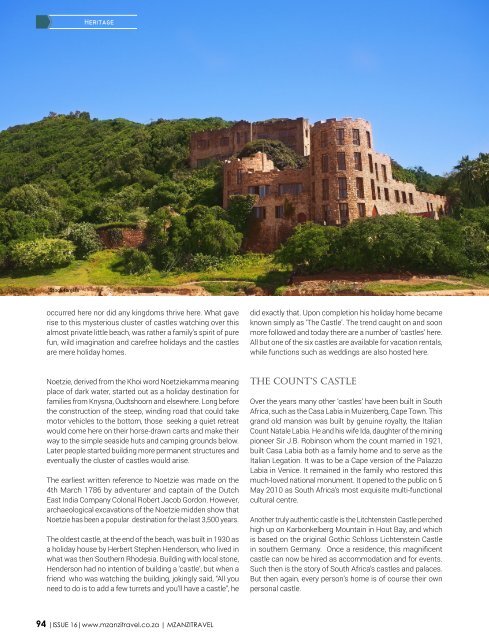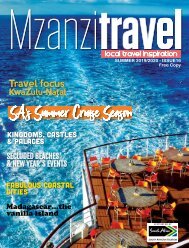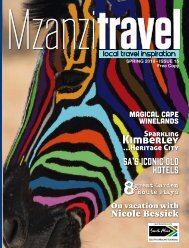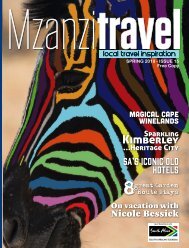MZANZI ISSUE 16
Create successful ePaper yourself
Turn your PDF publications into a flip-book with our unique Google optimized e-Paper software.
Heritage<br />
iStock-forgiss<br />
occurred here nor did any kingdoms thrive here. What gave<br />
rise to this mysterious cluster of castles watching over this<br />
almost private little beach, was rather a family’s spirit of pure<br />
fun, wild imagination and carefree holidays and the castles<br />
are mere holiday homes.<br />
did exactly that. Upon completion his holiday home became<br />
known simply as ‘The Castle’. The trend caught on and soon<br />
more followed and today there are a number of ‘castles’ here.<br />
All but one of the six castles are available for vacation rentals,<br />
while functions such as weddings are also hosted here.<br />
Noetzie, derived from the Khoi word Noetziekamma meaning<br />
place of dark water, started out as a holiday destination for<br />
families from Knysna, Oudtshoorn and elsewhere. Long before<br />
the construction of the steep, winding road that could take<br />
motor vehicles to the bottom, those seeking a quiet retreat<br />
would come here on their horse-drawn carts and make their<br />
way to the simple seaside huts and camping grounds below.<br />
Later people started building more permanent structures and<br />
eventually the cluster of castles would arise.<br />
The earliest written reference to Noetzie was made on the<br />
4th March 1786 by adventurer and captain of the Dutch<br />
East India Company Colonal Robert Jacob Gordon. However,<br />
archaeological excavations of the Noetzie midden show that<br />
Noetzie has been a popular destination for the last 3,500 years.<br />
The oldest castle, at the end of the beach, was built in 1930 as<br />
a holiday house by Herbert Stephen Henderson, who lived in<br />
what was then Southern Rhodesia. Building with local stone,<br />
Henderson had no intention of building a ‘castle’, but when a<br />
friend who was watching the building, jokingly said, “All you<br />
need to do is to add a few turrets and you’ll have a castle”, he<br />
The Count’s castle<br />
Over the years many other ‘castles’ have been built in South<br />
Africa, such as the Casa Labia in Muizenberg, Cape Town. This<br />
grand old mansion was built by genuine royalty, the Italian<br />
Count Natale Labia. He and his wife Ida, daughter of the mining<br />
pioneer Sir J.B. Robinson whom the count married in 1921,<br />
built Casa Labia both as a family home and to serve as the<br />
Italian Legation. It was to be a Cape version of the Palazzo<br />
Labia in Venice. It remained in the family who restored this<br />
much-loved national monument. It opened to the public on 5<br />
May 2010 as South Africa’s most exquisite multi-functional<br />
cultural centre.<br />
Another truly authentic castle is the Litchtenstein Castle perched<br />
high up on Karbonkelberg Mountain in Hout Bay, and which<br />
is based on the original Gothic Schloss Lichtenstein Castle<br />
in southern Germany. Once a residence, this magnificent<br />
castle can now be hired as accommodation and for events.<br />
Such then is the story of South Africa’s castles and palaces.<br />
But then again, every person’s home is of course their own<br />
personal castle.<br />
94 |<strong>ISSUE</strong> <strong>16</strong>|www.mzanzitravel.co.za | <strong>MZANZI</strong>TRAVEL
















